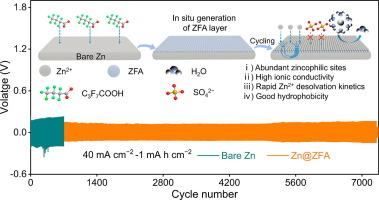Design principles of novel Zn fluorocarboxylate protection layer toward durable dendrite-free Zn metal anodes
IF 13.1
1区 化学
Q1 Energy
引用次数: 0
Abstract
Aqueous Zn ion batteries (ZIBs) have received extensive attention due to their intrinsic safety, high abundance, and low cost. However, uncontrolled dendrite growth and water-induced side reactions at electrode/electrolyte interfaces hinder the advancement of ZIBs. Herein, density functional theory (DFT) calculation indicates that Zn heptafluorobutyrate can facilitate uniform Zn2+ deposition by leveraging the abundant zincophilic groups (e.g., –COO− and –CF) and inhibit water-induced side reactions due to the presence of hydrophobic carbon chains. A Zn heptafluorobutyrate protective layer (denoted as ZFA) is constructed on the metallic Zn surface in situ by acid etching process to control Zn2+ desolvation and nucleation behaviors, ensuring enhanced reversibility and stability of Zn anodes. Consequently, the Zn@ZFA anode demonstrates stable operation for more than 2200 h at 1 mA cm−2 and over 7300 cycles at 40 mA cm−2, with high Coulombic efficiency of 99.8% over 1900 cycles at 5 mA cm−2. Impressively, Zn@ZFA||VO2 full cell achieves exceptional cycle life (204 mA h g−1 after 750 cycles at 3 A g−1) and remarkable rate performance (236 mA g−1 at 10 A g−1). This work provides an insightful guidance for constructing a protection layer of dendrite-free Zn anodes for high-performance ZIBs.

新型氟羧酸锌保护层的设计原理--实现耐用的无枝晶锌金属阳极
锌离子水电池(ZIBs)因其固有的安全性、高丰度和低成本而受到广泛关注。然而,在电极/电解质界面上不受控制的枝晶生长和水引发的副反应阻碍了 ZIB 的发展。在此,密度泛函理论(DFT)计算表明,七氟丁酸锌可利用丰富的亲锌基团(如 -COO- 和 -CF)促进 Zn2+ 的均匀沉积,并因疏水碳链的存在而抑制水引起的副反应。通过酸蚀刻工艺在金属锌表面原位构建了七氟丁酸锌保护层(简称 ZFA),以控制 Zn2+ 的脱溶和成核行为,从而确保提高锌阳极的可逆性和稳定性。因此,Zn@ZFA 阳极在 1 mA cm-2 下可稳定运行 2200 小时以上,在 40 mA cm-2 下可稳定运行 7300 个周期以上,在 5 mA cm-2 下可稳定运行 1900 个周期以上,库仑效率高达 99.8%。令人印象深刻的是,Zn@ZFA||VO2 全电池实现了超长的循环寿命(在 3 A g-1 条件下循环 750 次后达到 204 mA h g-1)和卓越的速率性能(在 10 A g-1 条件下达到 236 mA g-1)。这项工作为构建高性能 ZIB 的无枝晶 Zn 阳极保护层提供了深刻的指导。
本文章由计算机程序翻译,如有差异,请以英文原文为准。
求助全文
约1分钟内获得全文
求助全文
来源期刊

Journal of Energy Chemistry
CHEMISTRY, APPLIED-CHEMISTRY, PHYSICAL
CiteScore
19.10
自引率
8.40%
发文量
3631
审稿时长
15 days
期刊介绍:
The Journal of Energy Chemistry, the official publication of Science Press and the Dalian Institute of Chemical Physics, Chinese Academy of Sciences, serves as a platform for reporting creative research and innovative applications in energy chemistry. It mainly reports on creative researches and innovative applications of chemical conversions of fossil energy, carbon dioxide, electrochemical energy and hydrogen energy, as well as the conversions of biomass and solar energy related with chemical issues to promote academic exchanges in the field of energy chemistry and to accelerate the exploration, research and development of energy science and technologies.
This journal focuses on original research papers covering various topics within energy chemistry worldwide, including:
Optimized utilization of fossil energy
Hydrogen energy
Conversion and storage of electrochemical energy
Capture, storage, and chemical conversion of carbon dioxide
Materials and nanotechnologies for energy conversion and storage
Chemistry in biomass conversion
Chemistry in the utilization of solar energy
 求助内容:
求助内容: 应助结果提醒方式:
应助结果提醒方式:


